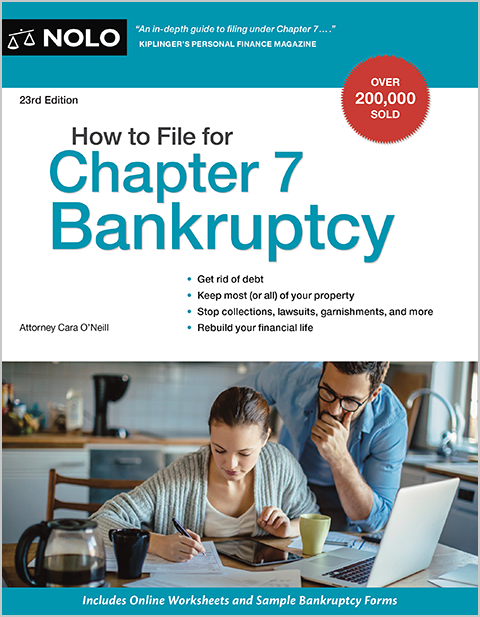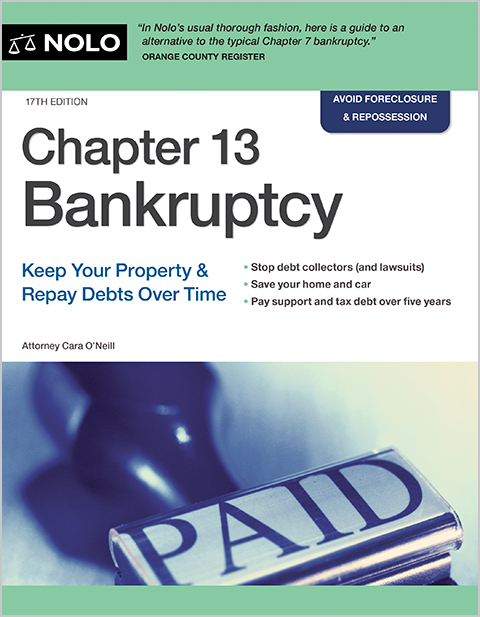Here's how to compare your income to your state's median family income.
Before receiving debt forgiveness in Chapter 7 bankruptcy, you must prove your income is low enough to pass the Chapter 7 means test. This article walks you through calculating and comparing your income to your state's median income figures. You'll learn how the Chapter 7 means test works and why you must compare your income to your state's median income.
We also explain the income types you'll include in your calculations, how to determine your family size, and whether you're exempt from taking the Chapter 7 means test.
- How Does the Chapter 7 Means Test Work?
- How Do I Compare My Income to My State's Median Income for the Chapter 7 Means Test?
- Quickly Calculate Your Income for the Chapter 7 Means Test: A Shortcut
- Instructions for Calculating Yearly Chapter 7 Means Test Income
- How Do I Find My State's Median Income for Chapter 7 Bankruptcy?
- Chapter 7 Means Test Family Size
- Do You Need to Take the Chapter 7 Means Test, or Are You Exempt?
- Need More Bankruptcy Help?
How Does the Chapter 7 Means Test Work?
Not everyone qualifies for an order erasing or "discharging" debt in Chapter 7 bankruptcy. With few exceptions, you must pass the Chapter 7 means test. The Chapter 7 means test determines whether you have disposable funds you could use to repay some portion of what you owe to your creditors.
The Chapter 7 means test is a two-part test. This article covers the first part, which compares your income to your state's median income. If your income is low enough, you'll qualify for a Chapter 7 discharge.
If you don't pass this part, you'll have another opportunity to qualify. The second part lets you deduct expenses from your income—some actual expenses and others based on federal and state standards. However, if you don't qualify for Chapter 7, filing for Chapter 13 might be an option.
Learn whether you're eligible for Chapter 13 bankruptcy.
How Do I Compare My Income to My State's Median Income for the Chapter 7 Means Test?
You'll calculate your current monthly income using the process explained in "Steps for Calculating Yearly Chapter 7 Means Test Income." Once complete, you'll convert the monthly figure to a yearly figure before comparing the amount to your state's median income. You'll find instructions and a link to the state median figures in "How Do I Find My State's Median Income for Chapter 7 Bankruptcy?"
Quickly Calculate Your Income for the Chapter 7 Means Test: A Shortcut
People with straightforward income that hasn't changed in the last year or has changed very little can skip the calculation step. For instance, this would apply to you if you've worked the same job for the previous year. If you fall into this category, which many people do, try this simple process instead.
Compare your gross earnings for the last twelve months to your state's median income for your family size. You'll pass if your earnings don't exceed the median. The state median figures are on the U.S. Trustee Program Means Testing webpage (page navigation instructions are below).
If you use the shortcut and the outcome is close, or if your income has fluctuated over the previous year, use the calculation method below for an accurate result.
Instructions for Calculating Yearly Chapter 7 Means Test Income
The Chapter 7 means test calculates your current monthly gross income, which you'll convert to a yearly gross income before comparing it to the state median figures. Before starting, review the reportable income types listed in "What Do I Include When Calculating My Monthly Income for the Chapter 7 Means Test?"
When you're ready to start calculating, use gross figures (pretax) for employment income, not what's left after subtracting taxes and other deductions. You'll use net income when reporting profits from business enterprises and rental properties. Also, include the income earned by all family members contributing to monthly expenses and money from roommates.
What Do I Include in My Chapter 7 Monthly Means Test Income?
Here's what you must include according to the categories on the Chapter 7 Statement of Your Current Monthly Income bankruptcy form:
- gross wages, salary, tips, bonuses, overtime, and commissions (before all payroll deductions)
- alimony and maintenance payments
- all amounts regularly received for household expenses from anyone (partner, children, parents, roommates), including child support
- net income from operating a business, profession, or farm
- net income from rental and other real property
- interest, dividends, and royalties
- unemployment compensation
- pension or retirement income
- income from all other sources
You won't include any benefit amount received under the Social Security Act. Also, don't include anything paid by the United States Government related to a disability, combat-related injury or disability, or death of a uniformed services member.
Important note. People receiving retired pay under Title 10, Chapter 61 might need to report it. Consult with a bankruptcy lawyer.
Steps to Calculating Your Monthly and Yearly Income for the Chapter 7 Means Test
Once you know what you must include in your current monthly income calculation, you can convert it to a yearly figure. Here are the steps:
- Determine the six-month calculation period. For instance, if today's date is May 15, your calculation period would be from November 1 through April 30.
- Add all gross employment and net business income earned during the last six months. Include other required income sources, such as dividends and interest, child support, and expense contributions from partners, family members, and roommates.
- Divide the total by six to arrive at your current monthly income.
- Multiply the current monthly income figure by 12 for your yearly income.
Example. John and Marcia are married and have two young children. Their calculated current monthly income is $5,400, and their annual income is $64,800 ($5,400 multiplied by 12).
Comparing Your Yearly Income to the State Median Income
You'll compare your yearly income to the state family median income for your family size. You'll pass the first portion of the means test and qualify for Chapter 7 bankruptcy if your income doesn't exceed the median amount.
Instructions and links to your state's means test numbers are below.
How Do I Find My State's Median Income for Chapter 7 Bankruptcy?
State median income figures are published several times each year on the U.S. Trustee Program website. Once on the site, follow these steps:
- Click on "Means Testing Information" (on the left navbar)
- Under "Data Required for Completing the 122A Forms and the 122C Forms," select the most recent option from the pulldown menu before clicking "Go."
- Click "Median Family Income Based on State/Territory and Family Size."
- Find your state and use the median income amount under your family's size.
If your yearly income exceeds your state's median income, you'll take the second portion of the Chapter 7 means test. If it doesn't, you'll pass the Chapter 7 means test.
Chapter 7 Means Test Family Size
You'll notice that the state median income amounts can account for up to four people. Use the multiplier at the bottom of the chart if you have additional family members. For example, the multiplier for additional family members at writing was $9,900. (This figure won't be updated, so check the website for current figures.)
If you need help determining who you can include in your household size for the means test, read Household Size and the Chapter 7 Means Test.
Do You Need to Take the Chapter 7 Means Test, or Are You Exempt?
Some military personnel and veterans are exempt from taking the means test. You can find out by reviewing the exemption qualifications on bankruptcy form Statement of Exemption from Presumption of Abuse Under § 707(b)(2).
Also, individuals with more business debt than consumer debt are exempt from the means test. Business debts are debts incurred while attempting to make a profit. When classifying debt types, you'll list personal income tax debt as business debt. Some courts also characterize student loans as business debt.
People incur consumer debts for personal goods and services, such as the following:
- housing, such as rent and mortgage balances
- food and clothing
- utility bills for the home, and
- credit card purchases for personal items and entertainment.
Although companies mainly use this form of bankruptcy, individuals sometimes have enough business debt to qualify. For instance, if you're a current or prior business owner responsible for business debt under a personal guarantee, you might be exempt from the means test. Also, a sole proprietor with primarily business debts might be exempt.
Need More Bankruptcy Help?
Did you know Nolo has made the law accessible for over fifty years? It's true—and we wholeheartedly encourage research and learning. You'll find many more helpful bankruptcy articles on Nolo's bankruptcy homepage, and information needed to complete the official downloadable bankruptcy forms is located on the Department of Justice U.S. Trustee Program.
However, online articles and resources can't address all bankruptcy issues and aren't written with the facts of your particular case in mind. The best way to protect your assets in bankruptcy is by hiring a local bankruptcy lawyer.
|
|
- How Does the Chapter 7 Means Test Work?
- How Do I Compare My Income to My State's Median Income for the Chapter 7 Means Test?
- Quickly Calculate Your Income for the Chapter 7 Means Test: A Shortcut
- Instructions for Calculating Yearly Chapter 7 Means Test Income
- How Do I Find My State’s Median Income for Chapter 7 Bankruptcy?
- Chapter 7 Means Test Family Size
- Do You Need to Take the Chapter 7 Means Test, or Are You Exempt?
- Need More Bankruptcy Help?

